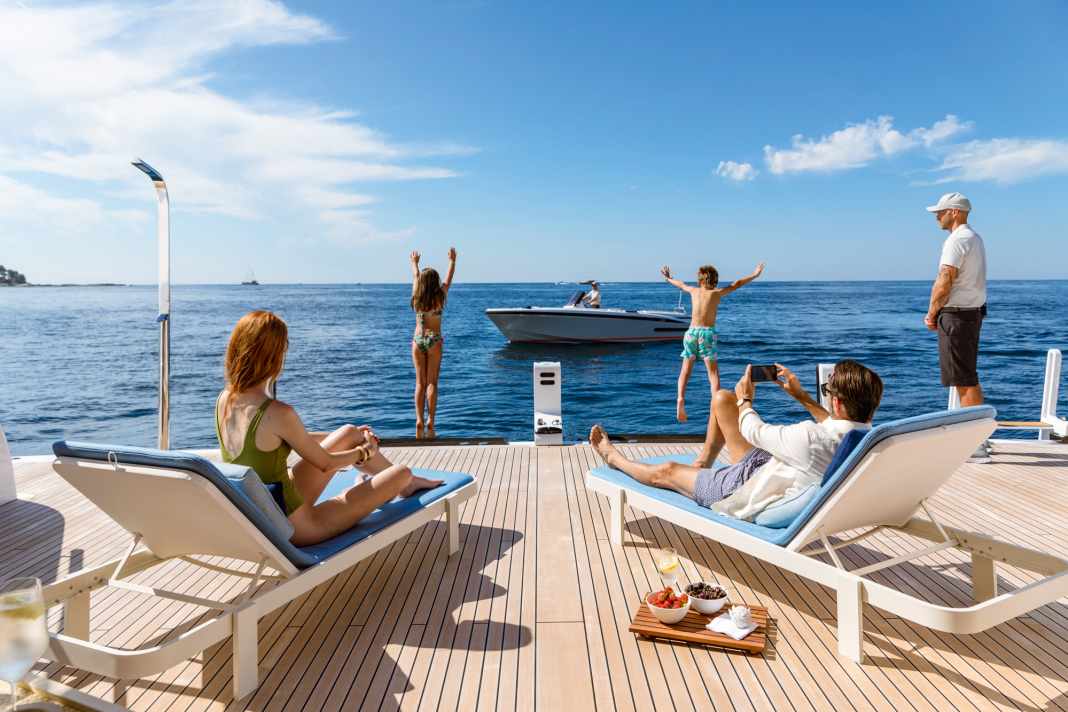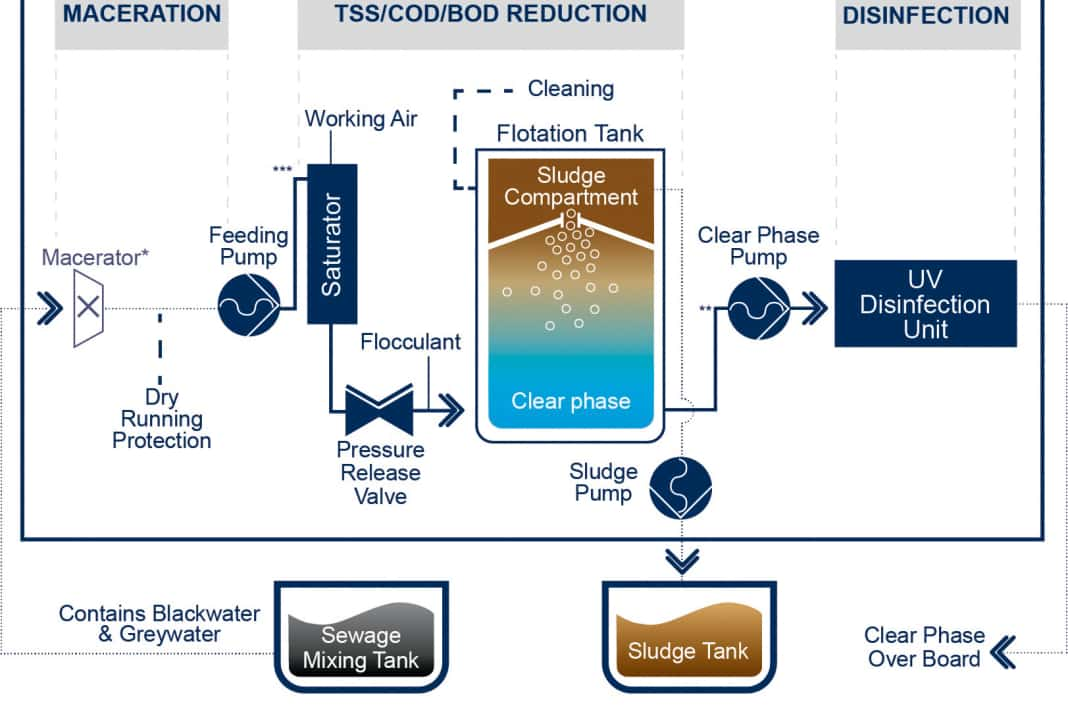





Anyone who anchors in a romantic bay in the Mediterranean and takes a dip in the sea never wants to experience this scenario: The captain of the neighbouring yacht opens the valves and empties the full tanks, the dirty water simply flows away. This is not only unpleasant and harmful to the environment, it is also illegal close to land.
The chances are high that the seawater will remain clean. More and more yachts have a sewage treatment plant because the owners want to act responsibly towards nature or because they have to. For a good 50 years, the IMO and the MARPOL Convention have regulated what happens to wastewater on board ships (and yachts), whether and under what conditions it may flow into the sea. Since then, the requirements have become increasingly strict. "The controls are also getting stricter," Olaf Hansen encourages potential swimmers. The engineer is technical manager at Hamann AG and therefore responsible for the development, construction and testing of marine wastewater treatment plants. He also knows: "There are checks in the harbours to see if they have been run."
Standard value for waste water on private yachts
A few figures reveal how a company from Hollenstedt in Lower Saxony builds its success on contaminated water and why treatment at sea is necessary: A cargo ship produces around 135 litres of wastewater per person per day - from vacuum toilets, showers and washbasins, from the galley and the laundry. Private yachts produce much more per person, the guests' demands are high and washing machines run around the clock. "We reckon on at least twice as much here," says Hamann Sales Manager Uwe Fredrich, "more likely four times as much." 450 litres is a guideline.
However, the capacity of a waste water tank is limited; for a 30-metre yacht, it holds around four tonnes. To prevent the whole thing from "overflowing", the waste water has to be treated so that it can be discharged underway. The sludge that remains on board after treatment and until the yacht enters the harbour makes up only two to four percent of the total wastewater and can be "temporarily stored" for longer.
Hamann's history is closely linked to the development of the law. The company started back in 1972. "We started in Hamburg-Barmbek with three employees," says current Managing Director Felix von Bredow, "now we have 90 people." The company has been operating from Hollenstedt since 2002 and has grown from a pure sales organisation to an "everything under one roof" manufacturer that welds and assembles virtually all stainless steel components. Only the pumps and the control cabinets with the control electronics are supplied - "for the time being", announces Felix von Bredow.
Customer base for waste water system
The company continues to grow and hall number four is almost finished on the site in the industrial estate on the A1 motorway. Further production areas and a canteen for free lunches for all employees are being added here. This is an important part of the corporate culture, after all, Hamann AG was awarded the "Employer of the Future" seal by the German Innovation Institute. Initially, the company's order books tended to contain orders from the commercial shipping sector, but in the 1980s it started to build private yachts, for example "Shergar" (47 metres, 1982) by Lürssen or "Gallant Lady" (52 metres, 1994) by Feadship. The built-in "mini" systems were still generously dimensioned, and shipyards such as Royal Huisman wanted even smaller formats. The "Super-Mini" was first installed in 1999 on the Huisman-Slup "Sassafras", ex-"Pamina" (34 m). The first Italian customer was the Overmarine Group, which ordered Hamann's systems for its Mangustas, recalls Uwe Fredrich. Today, the customer base includes many big names: the Ferretti Group, Sanlorenzo, Benetti, Baglietto, but also Conrad Shipyard from Poland and Sunseeker from the UK.
All custom yachts over 40 metres now have a system on board, explains Fredrich, pointing to a compactly arranged maze of tanks, pipes and pumps on a tour of production hall one. This "fiver", for example, is designed for a 60-metre yacht for 40 to 50 people and cleans 12,000 litres of waste water per day. But today, everything is ready for installation even on smaller series yachts. The number is increasing, as Uwe Fredrich can see from the orders. "Fortunately, awareness of wastewater is increasing," adds his colleague Georgios Kariofilis. Hamann AG now sees itself as the market leader for European yachts over 30 metres. "Every second one at the Monaco Yacht Show probably had one of our systems," surmise the two experts, who travel the world for advice and sales and acquire new customers at all the major trade fairs.
300 systems leave the premises every year. They are built to order, although Hamann also produces the most popular models in the raw version for stock. The lead time is then only a few weeks. The systems can be dismantled for installation and reassembled on board. Thanks to the modular design, "upgrades are also possible," assures Olaf Hansen. Of course, the stainless steel package can also be visually matched to the engine compartment; all RAL colours are possible. Tank and pipes in bright white or bright yellow? Gladly.
The service at Hamann
Service is part of this, not just detailed advice in advance. Once the package has been tested and installed, Hamann continues to support its customers. "We go through the entire system with the first engineer on board," explains Georgios Kariofilis, "the system has to work in practice. Always." While professionals usually work at sewage treatment plants on land, on ships there is only the engineer who has an overview, so "everything has to be user-friendly and understandable even for laypeople," adds Olaf Hansen. If something doesn't work later on, technicians travel to the site, and there are 25 service partners in addition to around 40 sales outlets worldwide.
Many systems last for decades. Even in the case of a major refit, such as the "Carinthia VII" from Lürssen (97 metres, built in 2002), hardly anything needs to be replaced as the package still fulfils the requirements and runs well. If something should break at some point, Hamann is sure to have the right part ready among the 22,000 individual and spare parts in hall three. "We endeavour to guarantee delivery for 30 years," promises Felix von Bredow.
If something changes in the design of a system today, then it tends to be in the direction of "even more maintenance-friendly". Sometimes a yacht only gets new equipment because it is to be upgraded with the current model or because the local regulations for the owner's favourite cruising area change and the equipment then has to perform better.
While the effect of a purification system is considerable, the costs are reasonable, especially in terms of the overall budget. For an 80-metre yacht, the Hamann package costs around 100,000 euros, not a huge sum according to Managing Director Felix von Bredow: "Many entertainment systems are more expensive."
How to get the dirt out of the water



Black water (from the toilets) and grey water (everything else) run together in a tank on smaller yachts around 30 metres, larger yachts usually have an extra black water tank. The kitchen waste water must first pass through a grease separator. Any lack of slope is compensated for by pumps, which transport the water to the next "action point".
A macerator shreds coarser waste (toilet paper), then it goes into the pressurised chamber (saturator), where air is pressed into the mixture at five bar. The wastewater enters the cleaning tank (flotation) via an expansion valve. There, the air bubbles bubble upwards and dirt particles adhere to them. Small amounts of a flocculant based on aluminium sulphide (35 milligrams are sufficient for around 1000 litres of wastewater) help with this. The particles bind together and rise upwards in groups. A "sludge cake" is formed at the top, which looks like cappuccino foam. This is collected and fed into the sludge tank via a pump. UV light disinfects the water before it is drained; e-coli bacteria, for example, die off.
The system runs for twelve to 16 hours a day. In the standard version for private yachts, it works without membranes or filters. Cleaning with the help of bacteria does not take place here; this only works with regular utilisation. "A superyacht is often only occupied by some of the crew for 80 per cent of the year," explains Uwe Fredrich, "then all the guests come on board at once, and the bacterial cultures can't cope with that."

